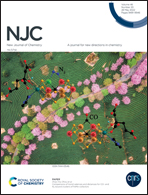Role of urea on the structural, textural, and optical properties of macroemulsion-assisted synthesized holey ZnO nanosheets for photocatalytic applications†
Abstract
Using a macroemulsion-assisted solvothermal method, the present study produces holey ZnO nanosheets exhibiting a hexagonal wurtzite crystal structure. In the synthetic process, urea is employed as a hydrolyzing agent. Its addition significantly affects the resulting ZnO products' crystal structure, morphology, textural, and optical properties. Different amounts of urea lead to the synthesis of ZnO with different crystallite sizes. A larger crystallite size leads to larger intercrystallite spaces, resulting in ZnO particles with a larger pore diameter but smaller pore volume. Furthermore, a lower urea concentration increases the visible light absorption and reduces the absorption coefficient of the final ZnO product. These phenomena may be attributed to the increased density of surface defects in the resulting ZnO nanocrystals. Moreover, the photoluminescence measurements for all samples reveal the yellow emission with a peak center at 2.2 eV (564 nm), attributed to the oxygen interstitials (Oi) defect. Finally, the photocatalytic test shows that the ZnO_U0.5 sample has the highest photodegradation rate constant, k = (4.25 ± 0.08) × 10−3 s−1, and a high photocatalytic efficiency of around 91.18%. The high photodegradation rate of this sample may be attributed to the synergistic effect of the holey sheet-like morphology, small crystallite size, high surface area, high density of defects, and small bandgap energy.



 Please wait while we load your content...
Please wait while we load your content...